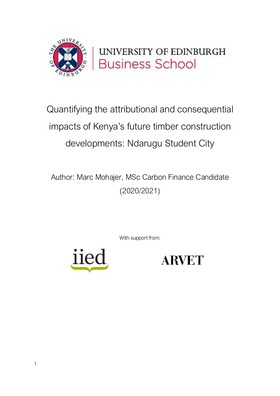Quantifying the attributional and consequential impacts of Kenya’s future timber construction developments: Ndarugu Student City

Earth is getting closer to experiencing temperature increases beyond the Paris Agreement targets. Climate change is affecting crop production, especially among African farmers who are looking for more resilient alternatives, including timber. African population growth is expected to double to 2.1 billion by 2050. Urban migration into cities such as Nairobi in Kenya will continue rapidly. Affordable housing is in short supply especially for groups like student. Here as elsewhere, the built environment is a major source of emissions (39% of total carbon emissions globally). Might wooden architecture, in for example the proposed Ndarugu Student City, reduce urban emissions while also incentivising smallholder tree-growing in supply chains that will further mitigate climate change and enhance climate resilience?
This study explores the interest for engineered wood or Cross Laminated Timber (CLT) to be used as a carbon removal method. It couples both attributional and consequential analyses to allow assessment of both the marginal and direct impact of timber buildings (in comparison with ‘business as usual’, and ‘best’ concrete and steel alternatives). It seeks to understand the environmental impacts of CLT versus concrete buildings in Kenya, and to provide policy and subsidy recommendations to further develop the forestry sector and a sustainable timber market within Kenya and Sub Saharan Africa more broadly.
Cite this publication
Available at https://www.iied.org/20556g

